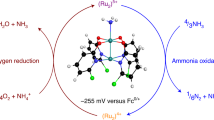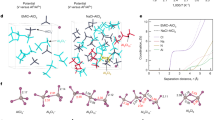Abstract
The desorption of dihydrogen from magnesium(II) hydride, MgH2 (containing 7.6 wt% H), is reversible. MgH2 therefore holds promise as a hydrogen storage material in devices powered by fuel cells. We believed that dimeric magnesium(I) dimers (LMgMgL, L = β-diketiminate) could find use as soluble models to aid the study of the mechanisms and/or kinetics of the hydrogenation of magnesium and its alloys. Here, we show that LMgMgL can be readily hydrogenated to yield LMg(µ-H)2MgL by treatment with aluminium(III) hydride complexes. In one case, hydrogenation was reversed by treating LMg(µ-H)2MgL with potassium metal. The hydrogenation by-products are the first thermally stable, neutral aluminium(II) hydride complexes to be produced, one of which, [{(IPr)(H)2Al}2] (IPr = :C[{(C6H3-i-Pr2-2,6)NCH}2]), is an N-heterocyclic carbene adduct of the elusive parent dialane(4) (Al2H4). A computational analysis of this compound is presented.
This is a preview of subscription content, access via your institution
Access options
Subscribe to this journal
Receive 12 print issues and online access
$259.00 per year
only $21.58 per issue
Buy this article
- Purchase on Springer Link
- Instant access to full article PDF
Prices may be subject to local taxes which are calculated during checkout



Similar content being viewed by others
Change history
13 October 2010
In the HTML version of this Article originally published, the e-mail addresses for the corresponding authors were assigned incorrectly. This has now been corrected.
References
Grochala, W. & Edwards, P. P. Thermal decomposition of the non-interstitial hydrides for the storage and production of hydrogen. Chem. Rev. 104, 1283–1316 (2004).
Schüth, B., Bogdanović, B. & Felderhoff, M. Light metal hydrides and complex hydrides for hydrogen storage. Chem. Commun. 2249–2258 (2004).
Aldridge, S. & Downs, A. J. Hydrides of the main-group metals: new variations on an old theme. Chem. Rev. 101, 3305–3365 (2001).
Graetz, J. New approaches to hydrogen storage. Chem. Soc. Rev. 38, 73–82 (2009).
Bogdanović, B., Ritter, A. & Spliethoff, B. Active MgH2–Mg systems for reversible chemical energy storage. Angew. Chem. Int. Ed. Engl. 29, 223–234 (1990).
Hanada, N., Ichikawa, T. & Fuji, H. Catalytic effect of nanoparticle 3d-transition metals on hydrogen storage properties in magnesium hydride MgH2 prepared by mechanical milling. J. Phys. Chem. B 109, 7188–7194 (2005).
Liang, G., Huot, J., Boily, S., Van Neste, A. & Schulz, R. Catalytic effect of transition metals on hydrogen sorption in nanocrystalline ball milled MgH2Tm (Tm=Ti, V, Mn, Fe and Ni) systems. J. Alloys Comp. 292, 247–252 (1999).
Andreasen, A. Hydrogenation properties of Mg–Al alloys. Int. J. Hydrogen Energy 33, 7489–7497 (2008).
Larsson, P., Araújo, C. M., Larsson, J. A., Jena, P. & Ahuja, R. Role of catalysts in dehydrogenation of MgH2 clusters. Proc. Natl. Acad. Sci. USA 105, 8227–8231 (2008).
Green, S. P., Jones, C. & Stasch, A. Stable magnesium(I) compounds with Mg–Mg bonds. Science 318, 1754–1756 (2007).
Green, S. P., Jones, C. & Stasch, A. Stable adducts of a dimeric magnesium(I) compound. Angew. Chem. Int. Ed. 48, 9079–9083 (2008).
Bonyhady, S. J., Green, S. P., Jones, C., Nembenna, S. & Stasch, A. A dimeric magnesium(I) compound as a facile two-center/two-electron reductant. Angew. Chem. Int. Ed. 48, 2973–2977 (2009).
Bonyhady, S. J., Jones, C., Nembenna, S., Stasch, A., Edwards, A. J. & McIntyre, G. J. β-Diketiminate stabilized magnesium(I) dimers and magnesium(II) hydride complexes: synthesis, adduct formation and reactivity studies. Chem. Eur. J. 16, 938–955 (2010).
Sidiropoulos, A., Jones, C., Stasch, A., Klein, S. & Frenking, G. N-heterocyclic carbene stabilized digermanium(0). Angew. Chem. Int. Ed. 48, 9701–9704 (2009).
Jones, C., McDyre, L., Murphy, D. M. & Stasch, A. Magnesium(I) reduction of benzophenone and anthracene: first structural characterisation of a magnesium ketyl. Chem. Commun. 46, 1511–1513 (2010).
Datta, A. How stable are the Mg–Mg bonds in magnesium(I) compounds towards hydrogenation? J. Phys. Chem. C 112, 18727–18729 (2008).
Iosub, V., Matsunaga, T., Tange, K. & Ishikiriyama, M. Direct synthesis of Mg(AlH4)2 and CaAlH5 crystalline compounds by ball milling and their potential as hydrogen storage materials. Int. J. Hydrogen Energy 34, 906–912 (2009).
Baker, R. J., Davies, A. J., Jones, C. & Kloth, M. Structural and spectroscopic studies of carbene and N-donor ligand complexes of group 13 hydrides and halides. J. Organomet. Chem. 656, 203–210 (2002).
Wang, Y. et al. A stable neutral diborene containing a B=B double bond. J. Am. Chem. Soc. 129, 12412–12413 (2007).
Cole, M. L., Jones, C., Junk, P. C., Kloth, M. & Stasch, A. Synthesis and characterization of thermally robust amidinato group 13 hydride complexes. Chem. Eur. J. 11, 4482–4491 (2005).
Ciobanu, O., Kaifer, E., Enders, M. & Himmel, H.-J. Synthesis of a stable B2H5+ analogue by protonation of a double base-stabilized diborane(4). Angew. Chem. Int. Ed. 48, 5538–5541 (2009).
Uhl, W. & Vester, A. Tetraalkylhydrido- und tetraalkylmethyldialuminat(5) mit aluminium–aluminium-binding: [R2Al-AlXR2]− {R=CH(SiMe3)2; X=H, Me}. Chem. Ber. 126, 941–945 (1993).
Version 5.34 of the Cambridge Structural Database, Cambridge Crystallographic Data Centre; search conducted December 2009.
Uhl, W. Organometallic compounds possessing Al–Al, Ga–Ga, In–In and Tl–Tl single bonds. Adv. Organomet. Chem. 51, 53–108 (2004).
Weng, X., Andrews, L., Tam, S., DeRose, M. E. & Fajardo, M. E. Infrared spectra of aluminum hydrides in solid hydrogen: Al2H4 and Al2H6 . J. Am. Chem. Soc. 125, 9218–9228 (2003).
Andrews, L. & Wang, X. The infrared spectrum of Al2H6 in solid argon. Science 299, 2049–2052 (2003).
Lammertsma, K., Güner, O. F., Drewes, R. M., Reed, A. E. & Schleyer, P. v. R. Remarkable structures of dialane(4), Al2H4 . Inorg. Chem. 28, 313–317 (1989).
Chesnut, D. B. A topological study of bonding in the Al2H2 and Al2H4 hydrides. Chem. Phys. 321, 269–276 (2006).
Nogai, S. & Schmidbaur, H. Dichlorogallane (HGaCl2)2: its molecular structure and synthetic potential. Inorg. Chem. 41, 4770–4774 (2002).
Wang, Y. et al. A stable silicon(0) compound with a Si=Si double bond. Science 321, 1069–1071 (2008).
Szabó, A., Kovács, A. & Frenking, G. Energy decomposition analysis of E–E bonding in planar and perpendicular X2E–EX2 (E=B, Al, Ga, In, Tl; X=H, F, Cl, Br, I). Z. Anorg. Allg. Chem. 631, 1803–1809 (2005).
Beste, A., Krämer, O., Fischer, A. & Frenking, G. The Lewis basicity of diaminocarbene—a theoretical study of donor–acceptor complexes of C(NH2)2, NH3 and CO with the Lewis acids EF3, ECl3 (E=B, Al, Ga, In), TiF4 and TiCl4 . Eur. J. Inorg. Chem. 2037–2045 (1999).
Tonner, R. & Frenking, G. Divalent carbon(0) chemistry. Part 2: protonation and complexes with main group and transition metal derived Lewis acids. Chem. Eur. J. 14, 3273–3289 (2008).
Acknowledgements
The research was supported by the Australian Research Council (fellowships for C.J. and A.S.) and the Deutsche Forschungsgemeinschaft (grant no. FR641/25-1 to G.F.). The EPSRC is also thanked for access to the UK National Mass Spectrometry Facility.
Author information
Authors and Affiliations
Contributions
Author listing order in the title is alphabetical. C.J. and A.S. conceived and designed the experiments. S.J.B., D.C. and A.S. performed the experiments. G.F. and N.H. carried out the computational studies. S.J.B., D.C., G.F., N.H., C.J. and A.S. analysed the data. C.J., A.S. and G.F. co-wrote the paper.
Corresponding authors
Ethics declarations
Competing interests
The authors declare no competing financial interests.
Supplementary information
Supplementary information
Supplementary information (PDF 1015 kb)
Supplementary information
Crystallographic data for compound 3 (CIF 15 kb)
Supplementary information
Crystallographic data for compound 4 (CIF 18 kb)
Supplementary information
Crystallographic data for compound 5 (CIF 21 kb)
Supplementary information
Crystallographic data for compound 9 (CIF 21 kb)
Supplementary information
Crystallographic data for compound 10·(cyclohexane) (CIF 22 kb)
Supplementary information
Crystallographic data for compound 11·(benzene)1.5 (CIF 64 kb)
Supplementary information
Crystallographic data for compound 12·(benzene)2 (CIF 25 kb)
Supplementary information
Crystallographic data for compound 13 (CIF 20 kb)
Supplementary information
Crystallographic data for compound 16 (CIF 27 kb)
Supplementary information
Crystallographic data for compound 17 (CIF 16 kb)
Supplementary information
Crystallographic data for compound 17·(benzene) (CIF 19 kb)
Rights and permissions
About this article
Cite this article
Bonyhady, S., Collis, D., Frenking, G. et al. Synthesis of a stable adduct of dialane(4) (Al2H4) via hydrogenation of a magnesium(I) dimer. Nature Chem 2, 865–869 (2010). https://doi.org/10.1038/nchem.762
Received:
Accepted:
Published:
Issue Date:
DOI: https://doi.org/10.1038/nchem.762
This article is cited by
-
New pathways of stability for NHCs derived from azole, di-azole, n-tetrazole, and ab-tetrazole, by DFT
Journal of Molecular Modeling (2020)
-
Anion stabilised hypercloso-hexaalane Al6H6
Nature Communications (2018)
-
Bimetallic aluminum alkyl and iodide complexes stabilized by a bulky bis-guanidinate ligand
Journal of Chemical Sciences (2018)
-
Dimeric magnesium(I) β-diketiminates: a new class of quasi-universal reducing agent
Nature Reviews Chemistry (2017)
-
Structure, bonding and energetics of N-heterocyclic carbene (NHC) stabilized low oxidation state group 2 (Be, Mg, Ca, Sr and Ba) metal complexes: A theoretical study
Journal of Chemical Sciences (2014)



